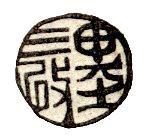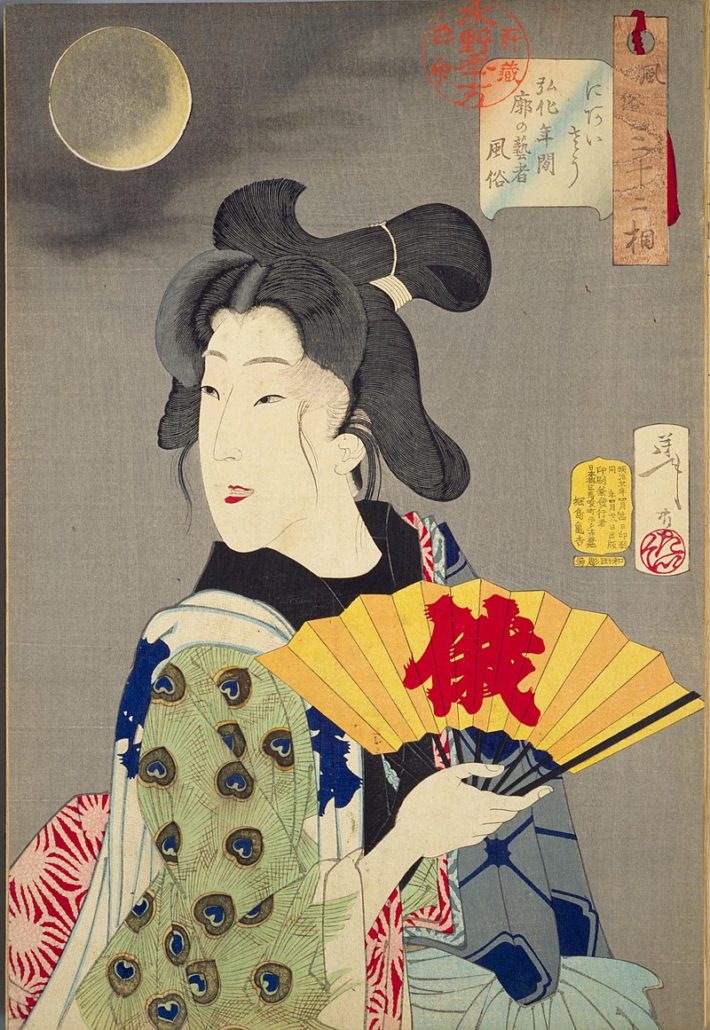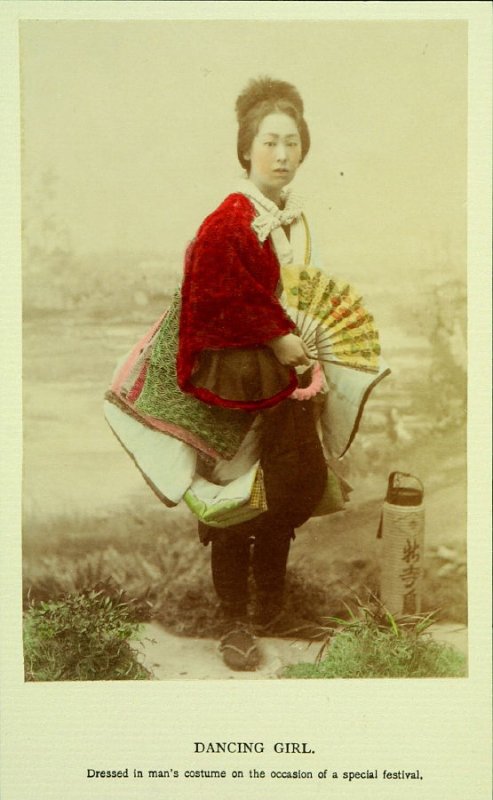Meiji Restoration & the Advent of photography
Icons of an Exotic Past
The Meiji Restoration brought even more significant social, political, and economic change to Japan than the reform period. Founded on the principle of “civilization and enlightenment,” the Meiji government modeled itself after the European powers of the time. Infrastructure was overhauled to connect the country through trains and telegraphs, a parliament was elected, and Western fashion started entering the upper class’s closets. The Meiji sought to compete with western powers, and like the feudal government that came before them, women were seen as an important piece of the puzzle. The new Ministry of Education began to promote the doctrine of “Ryosai Kenbo,” or “Good wife, Wise mother.” This was meant to be a standard that all Japanese women were to aspire to and that all subsequent policies regarding their dress, education, and agency in society would shape around.[1] The most effective tool for spreading this policy was new women’s schools being founded around the country where women had the opportunity to become literate and gain new skills, but only in the hopes they would raise productive sons for the Japanese nation-state.
The publishing industry was changing along with the rest of Japan, but many of the same artistic schools and publishing houses remained in the early years of the Meiji. The Utagawa school, which had previously been home to Kunisada and Hiroshige, was still producing prints. Tsukioka Yoshitoshi was the master of the newest generation of Ukiyo-e artists continuing the tradition into modern times. He would include a print of a geisha in tekomai in his 1888 series Thirty-Two Aspects of Customs and Manners; It is titled “Looking Suitable: The Customs of a Red-Light District Geisha in the Koka Era.” (Figure 11) The portrait of the cross-dressed geisha from the waist up depicts her with a half-smile. The shoulder closer to the viewer is clothed by a peacock patterned under-kimono, while the far shoulder still has the muted blue outer kimono pulled up. In her hand is a bright yellow fan with the word Niwaka written in bold red. Her hair is styled with loose forelocks and a ginko top knot. The background is a simple night sky with a full autumn moon, suggesting she is out participating in a festival. Yoshitoshi’s treatment of the subject is more erotic than Kunisada and Hiroshige II’s print. Her loose strands of hair and flirtatious expression seem more in line with a traditional bijinga series from before the Tempo reforms. While the Meiji government was beginning to police women in print and life, Yoshitoshi could still find publishers for his highly erotic bijinga works.
While this print and its series were somewhat provocative, they were depictions of the past which offered some ideological protection. Each image was intended to represent a different era of the Tokugawa period, with only the last few prints depicting the Meiji with their distinctly modern fashions. Each woman, therefore, became a representative of her time, an icon of an era. Yoshitoshi’s choice to include a cross-dressed woman to represent the feudal past is significant because it denies the image of entrance into modernity. His collection categorized the geisha’s gender play as a remnant of the feudal era, charming for its vintage appeal but not representative of modern Japan. And like the other Utagawa school artists in the decades after the Tenpo reforms, Yoshitoshi selected a geisha in tekomai and set her against the backdrop of Niwaka, an event hidden in the walls of Yoshiwara.
Yoshitoshi’s print represents a bookend to the story of the cross-dressed geisha image. His primary medium was print and while woodblock print would adapt and become a vehicle for modern art, Yoshitoshi’s work is firmly rooted in the older tradition of Ukiyo-e. His choice of medium was another wall that limited the cross-dressing geisha, like the dates of Niwaka and the gates of Yoshiwara. But Yoshitoshi’s print was not the only image of the cross-dressed woman appearing in the Meiji era and was not the only medium she would appear in. Two years later, souvenir photographer Kusakabe Kimbei sold a photograph from his Yokohama-based shop titled Dancing Girl (Figure 12). Like many of his photos of geisha, the young woman stands against a studio backdrop painted to look like the outdoors. At her feet are patches of grass and a handheld lantern likely emblazoned with her name or the name of her shop, just like the Eizan print from 1811. Kimbei meticulously colored the photograph so that all the signature colors of the costume can be seen: the red juban, the patterned kimonos, and the golden fan with the peony motif. The caption at the bottom of the photograph informs the viewer in English that this is a woman in a men’s costume for the occasion of a festival. Kimbei’s clientele were majority foreigners, so captions like this made his collection of photographs titillating trinkets for European and American travelers to bring home from their trip. Kimbei’s adaptions of bijinga through the lens of ethnographic photography still limited the image to the status of non-threatening beauty. While imbued with a Japanese sensibility, his work still provided an orientalist, exotic fantasy of Japan.[2] Through this lens, the cross-dressed woman became a spectacle again, but now for a global audience interested in what they perceive as a backward and alien culture. So, while the jump in medium represented an important step for depictions of the cross-dressed woman going forward, it was still far from the level of subversion they reached in the years before the Tenpo reforms. But entering the twentieth century, Kimbei’s photograph became a new crossroads because photography would become the predominant medium for the record of the cross-dressed woman.
Conclusion
The close examination of Figure 2 in this chapter has unveiled its importance as the example of Dansō iconography and the conceptual keystone that linked the visual representation of cross-dressed women before and after the Meiji Restoration. Before this print, cross-dressed women appeared as spectacles in Niwaka festival prints and as archetypes in Kunisada’s beauty collections. From those prints, Figure 2 exemplifies how mid-nineteenth-century printmakers negotiated their audiences’ tastes in the aftermath of the government’s conservative directives. Its version of the cross-dressed woman then proved influential even after the fall of the Shogunate’s rule. Tekomai survived the upheaval of the Meiji Restoration. It continued to be the subject of print used as a representative of the old feudal ways that had been left behind, but it also crossed over into photography, where it was sold as an exotic image of “strange” Japanese culture for foreign clientele.
The limitations still present in Kimbei’s photograph serve as a reminder that the town geisha, and by extension the early modern cross-dressed woman, was first and foremost a bijin: a beautiful spectacle constructed and displayed for the viewing pleasure of a male audience. She had a momentary influence on real-world women by becoming the archetype of their literature and expanding their options of expression within a rigid gender order. But that order was pushed back in the form of legislation, and when the dust settled, the cross-dressed woman survived but in a form that male audiences could still comfortably enjoy. The modern era began, and while the cross-dressed woman would be relegated to a feudal icon, her appearance in the earliest movements of Japanese photography would confirm her staying power in the minds and tastes of Japanese audiences. This new medium would open new doors of possibility for her aesthetic development.
[1] Sharon H. Nolte, and Sally Ann Hastings. “The Meiji State’s Policy Toward Women, 1890–1910.” In Recreating Japanese Women, 1600-1945, edited by Gail Lee Bernstein, (University of California Press, 1991,) 152-153.
[2] Mio Wakita, “Selling Japan: Kusakabe Kimbei’s Image of Japanese Women.” History of Photography 33, no. 2 (2009): 214.



